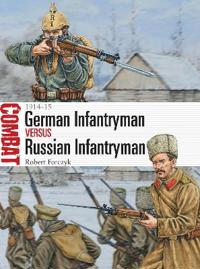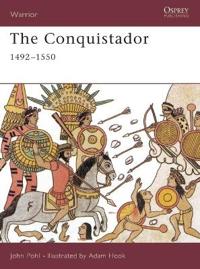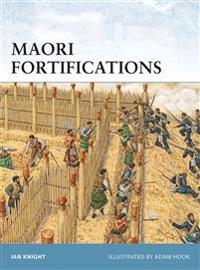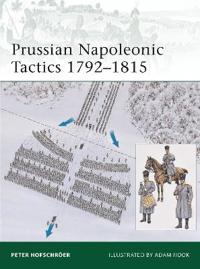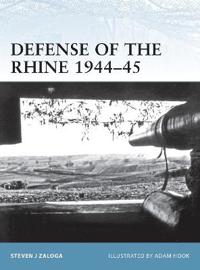Armies of the Russo-Polish War 1919-21 (Pocket)
avNigel Thomas, Adam (ILT) Hook, Nigel Thomas
ISBN: 9781472801067 - UTGIVEN: 2014-11In 1917 Poland was recognised as a state by Russia, but the Bolshevik coup threatened this. The Polish leader Marshal Pilsudski hurried to build an army around Polish World War I veterans, and in 1918 war broke out for Poland's independence, involving the Poles, the Red and White Russian armies, at [...]
German Infantryman Vs Russian Infantryman 1914-15 (Pocket)
avRobert Forczyk, Adam (ILT) Hook, Robert Forczyk
ISBN: 9781472806543 - UTGIVEN: 2015-04The Eastern Front of World War I is sometimes overshadowed by the fighting in the West. But the clashes between Imperial Germany and Tsarist Russia in East Prussia, Poland and Lithuania were every bit as gruelling for the participants as the great battles in Western Europe. In spite of the crushing [...]
The Conquistador (Pocket)
avJohn Pohl, Adam (ILT) Hook, John Pohl
ISBN: 9781841761756 - UTGIVEN: 2001-11The Conquest of Mexico is a legendary chapter in the annals of military history. Accounts vary, but all portray the fall of the Aztec Empire as a super-human feat achieved against hordes of superstitious savages by only a few hundred Spaniards armed with superior weaponry and guided by the military [...]
World War I Trench Warfare (I) 1914-16 (Pocket)
avStephen Bull, Adam (ILT) Hook, Stephen Bull
ISBN: 9781841761978 - UTGIVEN: 2002-02The years from 1914 to 1918 saw a whole series of complex and very rapid changes in infantry tactics, which fundamentally altered the way wars had been fought for 150 years. This two-part study describes and illustrates the development of infantry equipment and weapons; of support weapons; of field [...]
Kolin 1757 (Pocket)
avSimon Millar, Adam (ILT) Hook, Simon Millar
ISBN: 9781841762975 - UTGIVEN: 2001-10In May 1757 Frederick the Great invaded Bohemia, smashed an Austrian army outside Prague and bottled it up inside the besieged city. The Empress Maria Theresa could not sit by and allow the second city of the Empire to be captured and Marshal Daun was despatched with 60,000 fresh troops to its relie[...]
German Infantryman 1933-40 (Pocket)
avDavid Westwood, Adam (ILT) Hook, David Westwood
ISBN: 9781841764627 - UTGIVEN: 2002-11The common German infantryman played a crucial role in the events that led to the outbreak of war, and the burden of duty lay on his shoulders during the opening moves of the conflict, in the invasion of Poland, the conquest of Norway and Denmark, the Low Countries and France. The Wehrmacht was unst[...]
Siege Warfare in the Roman World (Pocket)
avDuncan B. Campbell, Adam (ILT) Hook, Duncan B. Campbell
ISBN: 9781841767826 - UTGIVEN: 2005-05Sieges played a central role in the many conflicts of the Ancient World and many famous generals, including Alexander the Great, Hannibal, Julius Caesar and Trajan, successfully used siegecraft to gain their objectives. This title explores the range of techniques and tactics which developed during t[...]
Maori Fortifications (Pocket)
avIan Knight, Adam (ILT) Hook, Ian Knight
ISBN: 9781846033704 - UTGIVEN: 2009-04The Maori people of New Zealand were experienced field engineers and it was common practice to protect villages with surrounding entrenchments and wooden palisades, known as pas. However, it was not until 1845, with the first fighting between the Maori and the British, that it became clear just how [...]
The Atlantic Wall (2) (Pocket)
avSteven J. Zaloga, Adam (ILT) Hook, Steven J. Zaloga
ISBN: 9781846033933 - UTGIVEN: 2009-11Germany's Atlantic Wall was the most ambitious military fortification program of World War II. Following its conquest of Western Europe, Germany had to defend some 5,000km of Atlantic coastline from the Spanish border to the Arctic Circle. The United States' entry into the war and the inevitability [...]
Prussian Napoleonic Tactics 1792-1815 (Pocket)
avPeter Hofschroer, Adam (ILT) Hook, Martin (EDT) Windrow
ISBN: 9781846035098 - UTGIVEN: 2011-10"Prussian Napoleonic Tactics: 1792-1815".
Defense of the Rhine 1944-45 (Pocket)
avSteven Zaloga, Adam (ILT) Hook, Steven Zaloga
ISBN: 9781849083874 - UTGIVEN: 2011-03The Rhine River represented the last natural defensive barrier for the Third Reich in the fall of 1944. Although Hitler had been reluctant to allow the construction of tactical defense lines in France, the final defense of the Reich was another matter. As a result, construction of a Rhine defense li[...]


